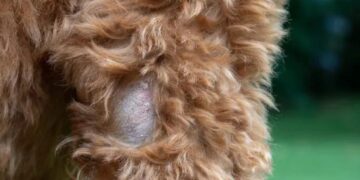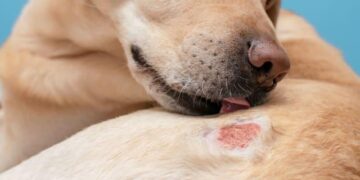Table of Contents
I’m a writer, a researcher, and a problem-solver by trade.
But for two agonizing years, the most complex problem I faced wasn’t in a book or on a screen.
It was the dry, flaky, miserable ears of my Basset Hound, Barnaby.
If you’re reading this, you probably know the particular kind of quiet heartbreak I’m talking about.
It’s the sound of incessant head-shaking in the middle of the night.
It’s the wince you feel when you see them scratch an already-raw ear.
It’s the endless cycle of hope and despair that comes with every new treatment.
Our journey was a classic tale of frustration.
We’d notice the edges of his magnificent, droopy ears getting crusty and flaky.
Then the itching would start.
A trip to our wonderful, well-meaning veterinarian would follow.
She’d take a swab, look under the microscope, and declare the culprit: a yeast infection [1].
We’d leave with a bottle of medicated ear drops and a surge of optimism.
For a week, maybe two, things would improve.
The redness would fade, the shaking would subside.
And then, just as we’d start to relax, it would all come roaring back.
Each time, the cycle repeated.
More vet visits, more medicated shampoos, more trial-and-error with different foods.
We were trapped in a loop, spending, as so many other owners have lamented in online forums, “THOUSANDS of dollars” on the same recurring problem with no end in sight [2].
I felt like I was failing him.
Despite following every piece of professional advice, my dog was still in a state of chronic discomfort.
The breakthrough, when it finally came, wasn’t a new medication or a miracle cure.
It was a complete shift in perspective.
I realized I was approaching the problem all wrong.
I was acting like a painter, constantly applying a fresh coat of paint to the cracks in a wall, only to watch them reappear.
I had to stop treating the symptoms and start investigating the system.
I had to become a house inspector.
This guide is the result of that journey.
It’s the framework that took us from the brink of despair to a place of lasting health and comfort for Barnaby.
It’s for every owner who feels like they’ve “tried everything” [1, 3].
I’m going to show you how to stop painting over the cracks and start inspecting the foundation, so you can finally solve the mystery of your dog’s chronic ear problems for good.
Part 1: The “Painter’s” Trap: Why We Kept Failing
Before we could find the solution, I had to understand why our efforts were consistently failing.
We were stuck in what I now call the “Painter’s Trap,” a frustrating cycle of treating surface-level symptoms without ever addressing the deep, underlying cause.
The “Whack-a-Mole” Problem
Our initial approach was a perfect example of what many dog owners experience: a frustrating game of dermatological whack-a-mole.
We would see a symptom—flaky skin, redness, a bad smell—and we would treat that specific symptom.
The vet would identify a secondary invader, usually yeast or bacteria that had taken advantage of the compromised skin, and prescribe a targeted treatment like an antifungal or antibiotic ear drop [1, 4].
And it would work, for a little while.
We were successfully “whacking” the mole.
But another one would pop up in its place a few weeks later because we never dealt with the machine that was making the moles appear.
We were treating the result of the problem—the infection—not the reason the skin was weak enough to get infected in the first place.
This is a common pitfall.
An estimated 20 percent of dogs suffer from some form of ear disease, and these episodes often become chronic because the primary trigger is missed [4].
As long as that trigger remained, the skin on Barnaby’s ears was a welcome mat for any opportunistic pathogen, leading to that soul-crushing cycle of recurrence [2, 5].
The Illusion of a Simple Diagnosis
The second, more insidious part of the trap was the belief that “dry, crusty ears” was a single, simple problem.
It’s not.
It’s a generic symptom, like a “check engine” light in a car.
That light doesn’t tell you if you need more oil or if your transmission is failing; it just tells you something is wrong.
I learned that a bewildering number of distinct medical conditions can all manifest as dry, flaky, scaly, or crusty skin on a dog’s ears [1, 6, 7].
The critical, and often missed, challenge is that many of these conditions are diagnostic mimics—they look nearly identical on the surface.
For example, the crusty, intensely itchy ear margins caused by Sarcoptic mange [8, 9] can look remarkably similar to the waxy, flaky buildup of Ear Margin Seborrhea [10, 11], which can also be confused with the inflammation and scabbing from an underlying allergy [1, 7].
This mimicry is the engine of the frustrating cycle.
An owner sees the crusty ear edges and seeks help.
A diagnosis is made, often focusing on the most obvious secondary infection.
The treatment targets that infection, but the true underlying cause—be it an allergy, a parasite, or a keratinization disorder—is left untouched.
As soon as the topical medication is stopped, the skin’s defenses are still compromised, and the secondary infection inevitably returns.
This is precisely why so many dedicated owners end up on forums, desperate for answers after trying multiple treatments that only provide temporary relief [1, 2].
They aren’t failing because the treatments are “wrong,” but because the treatments are aimed at a consequence, not the cause.
Part 2: The Epiphany: Stop Painting the Cracks, Start Inspecting the House
The turning point for Barnaby and me came late one night, after another failed round of treatment.
I was sitting on the floor, watching him miserably shake his head, and I felt a profound sense of defeat.
I had followed every instruction, administered every medication, and yet here we were, back at square one.
In a fit of desperation, I turned not to forums, but to veterinary dermatology textbooks and research papers.
As I read, a powerful analogy began to form in my mind, and it changed everything.
I realized I was behaving like a homeowner who hires a painter to fix a crack in the living room wall.
The painter applies spackle and a fresh coat of paint, and for a while, the wall looks perfect.
But a month later, the crack is back.
Why? Because the painter never asked why the crack appeared.
They never checked for a shifting foundation, a leaky pipe in the wall, or a structural flaw in the house’s frame.
They only addressed the surface blemish.
I was being a “Painter.” I was applying the “paint”—the ear drops, the creams, the medicated shampoos—to the “crack”—Barnaby’s dry, infected ears.
But I had never once acted like a “House Inspector.”
This became my new framework:
- The Painter sees only the surface problem. They focus on the redness, the flakes, the yeast, the bacteria. Their tools are topical creams and cleansers. Their goal is cosmetic repair, and the relief they provide is almost always temporary because the underlying structural issue remains.
- The House Inspector ignores the surface crack at first. Their job is to understand the integrity of the entire system. They start in the basement, checking the Foundation (Diet, Gut Health, and Allergies). They walk the Perimeter (External Parasites and Environmental Factors). They examine the Internal Systems (the “plumbing and electrical,” like underlying hormonal or systemic diseases). Only after they have confirmed that the entire structure is sound do they address the cosmetic cracks.
This simple analogy was a revelation.
It reframed the question from the helpless “How do I fix my dog’s dry ears?” to the empowered “What in my dog’s overall system is causing his ears to become dry?” It gave me a logical, methodical plan of investigation.
It turned me from a frustrated patient into a proactive partner in my dog’s health.
Part 3: The “Whole Dog” Inspection: A 4-Point System for Finding the Real Cause
Armed with my new “House Inspector” mindset, I developed a four-point inspection plan to work through with our vet.
This systematic approach is designed to move from the most common and foundational causes to the more specific and complex ones, ensuring no stone is left unturned.
Point 1: Checking the Foundation (Diet, Gut Health & Allergies)
The foundation of any healthy house—and any healthy dog—is what you build it with.
In canine health, this means nutrition.
The skin is often called the “mirror of the gut,” and for good reason.
Chronic inflammation that begins in the digestive system due to food sensitivities or allergies is a primary driver of skin problems, including the persistent inflammation that leads to ear infections [12, 13, 14].
In fact, allergies are implicated in a huge percentage of chronic ear issues, with some estimates suggesting up to 50% of dogs with allergic skin disease and 80% with food sensitivities will experience ear problems [4].
The Gold Standard: A Strict Elimination Diet
When you suspect a food allergy, the first instinct is to ask for a quick blood or saliva test.
However, multiple studies have shown that these tests are not reliable for diagnosing food allergies in dogs and cats [15].
The undisputed “gold standard” diagnostic tool is a meticulously conducted elimination diet [15, 16, 17].
This isn’t just about switching to a new bag of food.
It’s a rigorous diagnostic test that involves two main options, chosen with your vet [17]:
- A Novel Protein Diet: This involves feeding a protein source your dog has never been exposed to before. Common commercial proteins are chicken, beef, and lamb [18], so a novel protein might be something like kangaroo, rabbit, venison, or even alligator [19, 20, 21].
- A Hydrolyzed Protein Diet: In this veterinary therapeutic diet, the protein molecules are broken down into such small pieces that the dog’s immune system doesn’t recognize them as allergens, preventing a reaction [22, 23].
The process involves feeding only this special diet for a period of 8 to 12 weeks.
If the allergy symptoms resolve, you then “re-challenge” by reintroducing one ingredient from the old diet at a time to see if it triggers a reaction, thus confirming the culprit [22].
However, this is where most people fail.
The success of an elimination diet hinges on 100% compliance, and the modern dog’s life is filled with hidden potential allergens.
Flavored medications, dental chews, supplements in gelatin capsules, a licked plate from the dishwasher, a dropped piece of cheese from a toddler’s high chair, or even cross-contamination from another pet’s food bowl can all sabotage the trial [24, 25, 26, 27].
If the allergen is never truly eliminated, the symptoms never fully resolve, and the owner incorrectly concludes that the diet didn’t work.
To succeed, you must treat it like a scientific experiment.
The following table breaks down the process into a manageable protocol, helping you avoid the common pitfalls.
| Phase | Duration | Key Actions & Considerations |
| Phase 1: Preparation | 1 Week | Consult your vet to choose the right therapeutic diet (novel or hydrolyzed). Clean everything: Wash food bowls, storage bins, and scoops to remove old food residue. Inform the household: Ensure every family member, dog walker, and visitor understands the strict rules. Create “safe” treats: Bake small pieces of the new kibble or use bits of the new canned food as rewards. |
| Phase 2: Elimination | 8-12 Weeks | Feed ONLY the prescribed diet and water. This is non-negotiable. Avoid all hidden allergens: This includes flavored toothpaste, flavored heartworm/flea/tick preventatives (ask your vet for unflavored alternatives), supplements (unless cleared by your vet), rawhides and other chews, table scraps, and access to other pets’ food or the cat’s litter box [24, 27]. Keep a detailed symptom log: Track itching, redness, and head shaking on a scale of 1-10 daily. |
| Phase 3: The Re-Challenge | 1-2 Weeks per Ingredient | After symptoms have resolved, and with your vet’s guidance, reintroduce a single ingredient from the old diet (e.g., a small piece of plain, cooked chicken). Feed this one ingredient for up to two weeks. If symptoms return, you’ve found a trigger. Stop the challenge ingredient and wait for symptoms to resolve before testing the next one. If no symptoms appear, that ingredient is likely safe. |
| Phase 4: Long-Term Management | Ongoing | Based on the challenge results, work with your vet to formulate a complete and balanced long-term diet that avoids all identified trigger ingredients. |
Supportive Foundational Pillars
While the elimination diet is running, you can support the “foundation” with two key nutrients:
- Omega-3 Fatty Acids: These are powerful, natural anti-inflammatories. Sourced from fish oil or algae, they help strengthen the skin barrier from the inside out, improving the skin’s moisture balance and reducing the inflammation that drives itching [28, 29]. A deficiency in essential fatty acids can, by itself, cause dry, flaky skin and a dull coat [30, 31].
- Probiotics: A healthy gut is home to trillions of beneficial bacteria that play a critical role in regulating the immune system. An imbalance in this gut microbiome can lead to an overactive immune response, which is the hallmark of allergies. Supplementing with specific probiotic strains, such as Lactobacillus rhamnosus and Bacillus subtilis, can help modulate this immune response, strengthen the gut-skin axis, and reduce the allergic symptoms manifesting in the ears [12, 13, 14].
Point 2: Securing the Perimeter (Parasites & Environmental Triggers)
A good house inspector always checks for intruders before blaming the structure.
For dogs, this means ruling out external parasites and environmental factors that can cause ear irritation.
The Invisible Invaders
- Sarcoptic Mange (Canine Scabies): This is caused by a microscopic mite, Sarcoptes scabiei, that burrows into the skin [32]. It causes an intensely pruritic (itchy) reaction, often leading to frantic scratching, self-trauma, and thick, yellow crusts [9]. The classic distribution is on the ear margins (pinnae), elbows, and hocks (ankles) [8]. A key challenge with scabies is that the mites are notoriously difficult to find on skin scrapings; a negative scrape does not rule it out [9]. Because of this, and because it is highly contagious to other dogs, veterinarians will often perform a “therapeutic trial” by treating for scabies to see if the symptoms resolve [33].
- Ear Mites (Otodectes cynotis): These mites live primarily in the ear canal and are more common in puppies, but can certainly affect adult dogs [34, 35]. They cause intense itching and head shaking. The tell-tale sign of ear mites is a dark brown or black, crumbly discharge inside the ear that is often compared to coffee grounds [34, 36]. Unlike scabies mites, these are usually easy for a vet to spot with an otoscope [34].
Environmental Factors
- Moisture: The L-shaped anatomy of a dog’s ear canal makes it incredibly efficient at trapping fluid [4]. For dogs who love to swim or for any dog after a bath, trapped moisture creates a warm, dark, humid environment—a perfect breeding ground for yeast and bacteria [4, 37]. This is especially true for breeds with long, floppy ears like Basset Hounds and Cocker Spaniels, as the ear flap acts like a lid, preventing ventilation [38, 39]. Thoroughly drying the ears after any water exposure is a critical preventative step [4].
- Dry Air: Just as our skin gets dry in the winter, so can a dog’s. Forced-air heating systems reduce humidity in the home, which can lead to generalized dry, flaky skin, including on the ears [6, 40]. In some cases, simply using a humidifier in the room where your dog sleeps can make a noticeable difference [40].
- Contact Irritants: Less common but still possible are irritations from the environment, such as fly bites on the ear tips, which can cause crusty, bleeding sores [1, 41]. In some sensitive dogs, a contact dermatitis can develop in reaction to ingredients in topical ear medications themselves [41].
Point 3: Inspecting the Internal Systems (Underlying Disease)
If the foundation is solid (diet managed) and the perimeter is secure (parasites and environment ruled out), the inspector must look at the house’s internal wiring and plumbing—the dog’s own biological systems.
When the Skin Itself is the Problem
- Ear Margin Seborrhea (also called Ear Margin Dermatosis or Hyperkeratosis): This is a crucial condition to understand. It is not an infection or an allergy, but a primary disorder of keratinization [42, 43]. In simple terms, the skin cells on the edges of the ears are being produced and shed far too quickly. This results in a characteristic buildup of waxy, greasy, gray-to-yellow scales that stick to the hair shafts [10, 11]. These plugs of hair and scale can often be pulled out easily, leaving a shiny patch of skin behind. In severe cases, the ear margins can become thickened, swollen, and develop painful cracks or fissures [10]. This condition has a strong genetic link and is particularly common in breeds with pendulous ears, like Dachshunds, Cocker Spaniels, and Basset Hounds [10, 44, 45]. It’s important to know that this is often a lifelong condition that must be managed, not cured [1, 45, 46].
- Systemic and Hormonal Diseases: Sometimes, skin problems are a secondary sign of a deeper, body-wide issue. Endocrine disorders like hypothyroidism (low thyroid hormone) or Cushing’s disease (overproduction of cortisol) can compromise skin health and lead to secondary infections and seborrhea [6, 47]. These conditions are typically diagnosed via blood tests and often appear in middle-aged or older dogs [42].
The Symptom-Cause Inversion
One of the most profound “aha” moments for me was understanding the cause of the painful, bleeding cracks (fissures) that would sometimes appear on the very edge of Barnaby’s ears.
Like many owners I’ve seen in forums, my first instinct was to see the wound as the primary problem.
I would panic, apply pressure, and focus all my energy on getting the bleeding to stop.
I was wrong.
The fissure wasn’t the cause; it was the result.
The true cause was an unbearable itch deep within his ear, likely from his underlying allergies [3].
To relieve that itch, he would shake his head with incredible violence.
The delicate skin and blood vessels at the very tip of his heavy, floppy ears couldn’t withstand the force, and they would literally split open from the trauma.
The same can happen from intense scratching with a hind paw [34].
By focusing only on the bleeding crack, I was treating the final, dramatic symptom while ignoring the engine driving the whole process.
The internal itch remained, so the head-shaking continued, and the wound could never properly heal.
It was an “endless cycle of awfulness,” as one owner perfectly described it [3].
This realization reinforces the entire “House Inspector” model: you must find and resolve the reason for the head-shaking before you can ever hope to heal the damage it causes.
To help you and your vet navigate the diagnostic mimicry, this table provides a comparative overview of the most common culprits behind crusty ear margins.
| Condition | Key Symptoms & Appearance | Itch Level & Location | Key Diagnostic Clues |
| Sarcoptic Mange | Thick, yellow crusts; hair loss; self-inflicted wounds from scratching. [9] | Intense, frantic itching. Primarily on ear margins, elbows, hocks, and belly. [8] | Highly contagious to other dogs; may affect humans. Mites are hard to find on scrapings, so a positive response to a trial treatment is a strong indicator. [9, 33] |
| Ear Mites | Dark brown/black, dry, crumbly discharge resembling coffee grounds inside the ear canal. [34] | Variable, but can be severe. Itching is focused in and around the ears; causes vigorous head shaking. [32] | Mites are usually visible to a vet with an otoscope. More common in puppies but can affect adults. [34, 35] |
| Ear Margin Seborrhea | Waxy, greasy, gray-yellow scales adherent to hair shafts on ear margins. Hair may pull out in plugs. Skin can be thick, shiny, or fissured. [10, 11] | Usually low to no itching, unless a secondary infection or severe fissures are present. [48] | Strong breed predisposition (Dachshunds, Spaniels, Bassets). Lesions are typically on both ear margins. [10, 45] |
| Allergy-Related Dermatitis | Redness, inflammation, scabbing, hair loss, and sometimes a moist or smelly discharge from secondary infection (yeast/bacteria). [1] | Moderate to severe itching. Can affect ears, paws, face, and underside. Often accompanied by recurrent ear infections inside the canal. [6, 24] | Often seasonal if environmental; year-round if food-related. Responds to a strict elimination diet or allergy medications. [6, 49] |
Point 4: The Surface-Level Toolkit (Topical Care as Support)
Only after a thorough inspection of the foundation, perimeter, and internal systems do we return to the surface.
Topical treatments are not the cure, but they are essential supportive tools.
Their role is to provide comfort, maintain hygiene, and help the skin heal while you and your vet are addressing the primary, root cause.
- Healing Balms and Moisturizers: For conditions like seborrhea or environmentally-induced dryness, keeping the skin hydrated is key. However, it’s crucial to avoid human products like Vaseline, which is petroleum-based and can clog pores, potentially trapping bacteria and worsening an infection [50]. Instead, use a high-quality, vet-approved moisturizing balm, perhaps one containing natural ingredients like coconut oil, to soften the keratin buildup and soothe the skin [46, 50].
- Medicated Shampoos: These are a cornerstone of managing seborrhea. Shampoos containing keratolytic agents like sulfur, salicylic acid, or benzoyl peroxide work by helping to break down and remove the excess scale and keratin plugs [10, 42, 45]. If a secondary bacterial or yeast infection is present, your vet will prescribe a shampoo with antibacterial (e.g., chlorhexidine) or antifungal (e.g., miconazole, ketoconazole) ingredients [42].
- Gentle, Regular Cleaning: Keeping the ears free of debris is important for preventing secondary infections. Use a veterinarian-recommended ear cleaner and a soft cotton ball or cloth to gently wipe the parts of the ear you can see [7]. Never insert anything, like a cotton swab, deep into the ear canal, as this can cause serious damage [7]. It’s also vital to recognize that over-cleaning can strip the skin of its natural oils and cause irritation, so follow your vet’s guidance on frequency [40, 51].
Part 4: Your Blueprint for Success: Partnering with Your Vet
This entire framework is designed to do one thing: transform you from a passive, frustrated recipient of care into an informed, proactive partner with your veterinarian.
The “House Inspector” model gives you the language and the logic to navigate this complex problem effectively.
Preparing for Your Vet Visit
Your vet is your most important ally, but they can only work with the information you provide.
Before your appointment, become a detective.
- Document Everything: Create a detailed timeline. When did the symptoms start? Do they get worse at certain times of the year? What have you tried so far, and what were the results?
- Create a Food Diary: Write down every single thing your dog has eaten for the past several months—brands of food, treats, dental chews, table scraps. This is invaluable for identifying a potential novel protein for an elimination diet [4, 17].
- Take Photos and Videos: A picture is worth a thousand words. Take clear photos of the affected ears. Take videos of your dog shaking their head or scratching. This objective evidence is far more useful than just describing the behavior [4].
Asking the Right Questions
Armed with your documentation and the “House Inspector” framework, you can guide the conversation in a more productive direction.
Instead of just saying “His ears are bad again,” you can ask targeted questions:
- “We’ve treated a yeast infection twice now, and it keeps returning. I’m concerned about an underlying cause. Could we investigate the possibility of sarcoptic mange or an allergy?”
- “Given that he is a [insert breed], I’ve read about a condition called ear margin seborrhea. Do his symptoms align with that, and what would be the diagnostic steps to confirm or rule it out?”
- “I’m committed to doing a strict, 12-week elimination diet to definitively test for a food allergy. Can you help me select the most appropriate veterinary therapeutic diet and go over the protocol to ensure we do it correctly?”
Understanding the Diagnostic Process
By asking these questions, you show your vet you’re a serious partner.
This will help them as they perform their own inspection, which will likely include:
- Otoscopic Exam: Looking deep into the ear canal with a lighted scope to check for debris, foreign bodies, inflammation, and the integrity of the eardrum [4, 35].
- Skin Scraping: Gently scraping the skin to look for mites like Sarcoptes scabiei under a microscope [8, 40].
- Cytology: Taking a swab of the debris from the ear, staining it, and examining it under a microscope to identify the presence of yeast, bacteria, or inflammatory cells [4, 52].
This process isn’t about finding a quick fix; it’s about systematically ruling out possibilities to arrive at the correct diagnosis.
Conclusion: From Chronic Stress to Confident Care
I won’t pretend the journey was easy.
The elimination diet required vigilance and “tough love” when Barnaby would look at me with his soulful, pleading eyes for a forbidden treat [22].
It took patience and a significant investment of time and energy.
But the payoff has been immeasurable.
Today, Barnaby’s ears are healthy, soft, and comfortable.
The endless cycle of itching, shaking, and pain is gone.
We discovered through our “inspection” that he has a significant allergy to chicken and a milder sensitivity to storage mites, which are common in dry kibble “.
By switching him to a wet, novel protein diet (in our case, venison) and being meticulous about his treats, we addressed the root cause.
The foundation of his “house” is now stable, and the cracks in the walls have disappeared for good.
Lasting relief for chronic ear problems rarely comes from a single magic bullet.
It doesn’t come from a cream, a drop, or a pill.
It comes from a paradigm shift.
It comes from refusing to be a “Painter” who only papers over the symptoms, and choosing instead to become a methodical, knowledgeable “House Inspector” who investigates the entire system.
This path requires patience.
It requires a strong partnership with your veterinarian.
But it is a path that leads out of the woods of confusion and frustration.
By using this framework, you can move from a place of helplessness to one of confidence, finally giving your beloved dog the one thing you’ve wanted all along: lasting comfort and a life free from pain.
Works cited
- Ear Dermatitis in Dogs – Symptoms, Causes, Diagnosis, Treatment …, accessed August 12, 2025, https://wagwalking.com/condition/ear-dermatitis
- HELP! Lab’s Neverending Ear & Yeast Problems 🙁 | Dog Food Advisor, accessed August 12, 2025, https://www.dogfoodadvisor.com/forums/topic/help-labs-neverending-ear-yeast-problems/
- [HELP] Please, please help us with our dog’s ear margin dermatosis …, accessed August 12, 2025, https://www.reddit.com/r/dogs/comments/638nn7/help_please_please_help_us_with_our_dogs_ear/
- Dog Ear Infections: Symptoms, Causes, Treatment, and Prevention, accessed August 12, 2025, https://www.akc.org/expert-advice/health/dog-ear-infections/
- Dog Shaking Head & Scratching His Ears – Ask a Vet Online, accessed August 12, 2025, https://vethelpdirect.com/vetblog/2013/06/04/dog-shaking-head/
- Dandruff & Dry Skin on Dogs | Animal Hospital of Clemmons, accessed August 12, 2025, https://www.animalhospitalofclemmons.com/site/veterinary-pet-care-blog/2023/04/15/dog-dandruff-dry-skin
- Crusty Dog Ears: Causes and Care – Bayshore Veterinary Hospital, accessed August 12, 2025, https://bayshore-vet.com/veterinary-blog/crusty-dog-ears/
- Sarcoptic Mite – Companion Animal Parasite Council, accessed August 12, 2025, https://capcvet.org/guidelines/sarcoptic-mite/
- Mange in Dogs and Cats – Integumentary System – Merck Veterinary Manual, accessed August 12, 2025, https://www.merckvetmanual.com/integumentary-system/mange/mange-in-dogs-and-cats
- Ear Margin Seborrhea in Dogs – Ear Disorders – Merck Veterinary …, accessed August 12, 2025, https://www.merckvetmanual.com/ear-disorders/diseases-of-the-pinna/ear-margin-seborrhea-in-dogs
- Ear Margin Seborrhea in Dogs – Ear Disorders – MSD Veterinary Manual, accessed August 12, 2025, https://www.msdvetmanual.com/ear-disorders/diseases-of-the-pinna/ear-margin-seborrhea-in-dogs
- Are Probiotics Good for Dogs with Itchy Skin (Pruritus)? – Bonza, accessed August 12, 2025, https://www.bonza.dog/2025/01/are-probiotics-good-for-dogs-with-itchy-skin-pruritus/
- Do Probiotics Help Dogs with Itchy Skin? – Honest Paws, accessed August 12, 2025, https://www.honestpaws.com/blogs/probiotics/probiotics-for-dogs-with-itchy-skin
- Probiotics for Dogs with Allergies: Recommended Use, How to Choose the Right One, accessed August 12, 2025, https://www.honestpaws.com/blogs/probiotics/probiotic-dog-allergy
- Diet Elimination Trials | Purina Institute, accessed August 12, 2025, https://www.purinainstitute.com/centresquare/therapeutic-nutrition/diet-elimination-trials
- Managing Food Allergies with an Elimination Diet – Animal Kingdom Veterinary Hospital, accessed August 12, 2025, https://animalkingdomvet.net/blog/managing-food-allergies-with-an-elimination-diet/
- Implementing an Elimination-Challenge Diet Trial Dog | VCA Animal Hospitals, accessed August 12, 2025, https://vcahospitals.com/know-your-pet/implementing-an-elimination-challenge-diet-trial-dog
- Allergy-Friendly Novel Protein Diets – Stella & Chewy’s, accessed August 12, 2025, https://help.stellaandchewys.com/hc/en-us/articles/35923753496468-Allergy-Friendly-Novel-Protein-Diets
- Novel Proteins – Dr. Judy Morgan’s Naturally Healthy Pets, accessed August 12, 2025, https://drjudymorgan.com/blogs/blog/novel-proteins
- Novel Protein Diet for Dogs – Better Alternatives? – Bonza, accessed August 12, 2025, https://www.bonza.dog/2025/05/novel-protein-diet-for-dogs-better-alternatives/
- What Is the Best Novel Protein Diet for Dogs? – Whole Dog Journal, accessed August 12, 2025, https://www.whole-dog-journal.com/food/what-is-the-best-novel-protein-diet-for-dogs/
- Diagnosing Food Allergies in Dogs: Elimination Diet Trials – Chappelle Veterinary Clinic, accessed August 12, 2025, https://chappellevet.ca/diagnosing-food-allergies-in-dogs-elimination-diet-trials/
- Food Allergy: Diagnostics & Therapeutic Food Options | Today’s Veterinary Practice, accessed August 12, 2025, https://todaysveterinarypractice.com/nutrition/food-allergy-diagnostics-therapeutic-food-options/
- Common Signs of a Food Allergy in Pets – Anicira, accessed August 12, 2025, https://anicira.org/resources/common-signs-of-a-food-allergy-in-pets/
- Starting a hydrolized diet to check for food allergies, need some ideas! : r/dogs – Reddit, accessed August 12, 2025, https://www.reddit.com/r/dogs/comments/10725lf/starting_a_hydrolized_diet_to_check_for_food/
- Elimination Diet Trial Tips – Animal Allergy and Ear Clinic, accessed August 12, 2025, https://animalallergyandearclinic.com/elimination-diet-trial-tips/
- DIET TRIAL INSTRUCTIONS FOR DOGS – Nextmune, accessed August 12, 2025, https://go.nextmune.com/hubfs/NX_Diet_Trial_for_Dogs-1.pdf
- 6 Benefits of Omega-3’s For Your Dog’s Skin Health – Pet Honesty, accessed August 12, 2025, https://www.pethonesty.com/blogs/blog/6-benefits-of-omega-3s-for-your-dogs-skin-health
- Why Dogs Needs Omega-3 Supplements: Benefits and Sources – QRILL Pet, accessed August 12, 2025, https://www.qrillpet.com/blog-and-news/why-dogs-need-omega-3-supplements
- Is Fish Oil Good For Dogs? Dosage & Side Effects To Know, accessed August 12, 2025, https://wearethecure.org/is-fish-oil-good-for-dogs/
- Fatty Acid Benefits in Dog’s Health – Hill’s Pet Nutrition, accessed August 12, 2025, https://www.hillspet.com/dog-care/nutrition-feeding/fatty-acids-for-dogs
- Mite Infestation (Mange, Acariasis, Scabies) in Dogs – Merck Veterinary Manual, accessed August 12, 2025, https://www.merckvetmanual.com/dog-owners/skin-disorders-of-dogs/mite-infestation-mange-acariasis-scabies-in-dogs
- Sarcoptic mange (scabies) | Cornell University College of Veterinary Medicine, accessed August 12, 2025, https://www.vet.cornell.edu/departments-centers-and-institutes/riney-canine-health-center/canine-health-information/sarcoptic-mange-scabies
- Ear Mites In Dogs: What Owners Need To Know – American Kennel Club, accessed August 12, 2025, https://www.akc.org/expert-advice/health/ear-mites-in-dogs/
- Ear Infections in Dogs (Otitis Externa) | VCA Animal Hospitals, accessed August 12, 2025, https://vcahospitals.com/know-your-pet/ear-infections-in-dogs-otitis-externa
- 7 Common Ear Problems in Dogs – Cupertino Animal Hospital, accessed August 12, 2025, https://cupertinovet.com/7-common-ear-problems-in-dogs/
- Dog & Cat Ear Infections: Signs, Causes & Treatment – VCA Animal Hospitals, accessed August 12, 2025, https://vcahospitals.com/shop/home/articles/six-common-causes-of-ear-infections-in-pets
- Dog Ear Infection Symptoms: How to Prevent and Treat | AKC Pet Insurance, accessed August 12, 2025, https://www.akcpetinsurance.com/blog/treating-and-preventing-ear-infections
- Is There A Connection Between Dog Grooming and Ear Infections? – American Kennel Club, accessed August 12, 2025, https://www.akc.org/expert-advice/health/can-grooming-cause-ear-infections/
- Dog Dry Skin: Causes, Treatments, and Prevention – PetMD, accessed August 12, 2025, https://www.petmd.com/dog/symptoms/dry-flaky-skin-dogs
- Disorders of the Outer Ear in Dogs – Dog Owners – Merck Veterinary Manual, accessed August 12, 2025, https://www.merckvetmanual.com/dog-owners/ear-disorders-of-dogs/disorders-of-the-outer-ear-in-dogs
- Seborrhea in Dogs – Dog Owners – Merck Veterinary Manual, accessed August 12, 2025, https://www.merckvetmanual.com/dog-owners/skin-disorders-of-dogs/seborrhea-in-dogs
- Canine Seborrhea: Symptoms, Causes & Solutions – Lavengel, accessed August 12, 2025, https://lavengel.com/pages/skin-issues-seborrhea
- Seborrhea in Dogs – Veterinary Partner – VIN, accessed August 12, 2025, https://veterinarypartner.vin.com/default.aspx?pid=19239&catId=254091&id=4951988
- Ear Margin Dermatosis – WikiVet English, accessed August 12, 2025, https://en.wikivet.net/Ear_Margin_Dermatosis
- Hyperkeratosis In Dogs – Wag!, accessed August 12, 2025, https://wagwalking.com/condition/ear-margin-hyperkeratosis
- What Do You Do When Ear Drops and Oral Antibiotics Don’t Work? – VETzInsight – VIN, accessed August 12, 2025, https://www.vin.com/vetzinsight/default.aspx?pid=756&catId=5860&id=7885424
- Dermatologic Diseases of the Auricle – WSAVA2006 – VIN, accessed August 12, 2025, https://www.vin.com/apputil/content/defaultadv1.aspx?id=3859284&pid=11223
- Itchy Dog | Animal Welfare Professionals – Maddie’s Pet Forum, accessed August 12, 2025, https://forum.maddiesfund.org/discussion/itchy-dog
- What Causes Dry Dog Ears? How to Heal Them Naturally, accessed August 12, 2025, https://naturaldog.com/blogs/whole-dog-health/causes-dry-dog-ears-relief
- How to Clean a Dog’s Ears – American Kennel Club, accessed August 12, 2025, https://www.akc.org/expert-advice/health/how-to-clean-dogs-ears/
- Seborrhea in Dogs: Symptoms and Treatment – PetMD, accessed August 12, 2025, https://www.petmd.com/dog/conditions/skin/c_dg_canine_seborrhea






